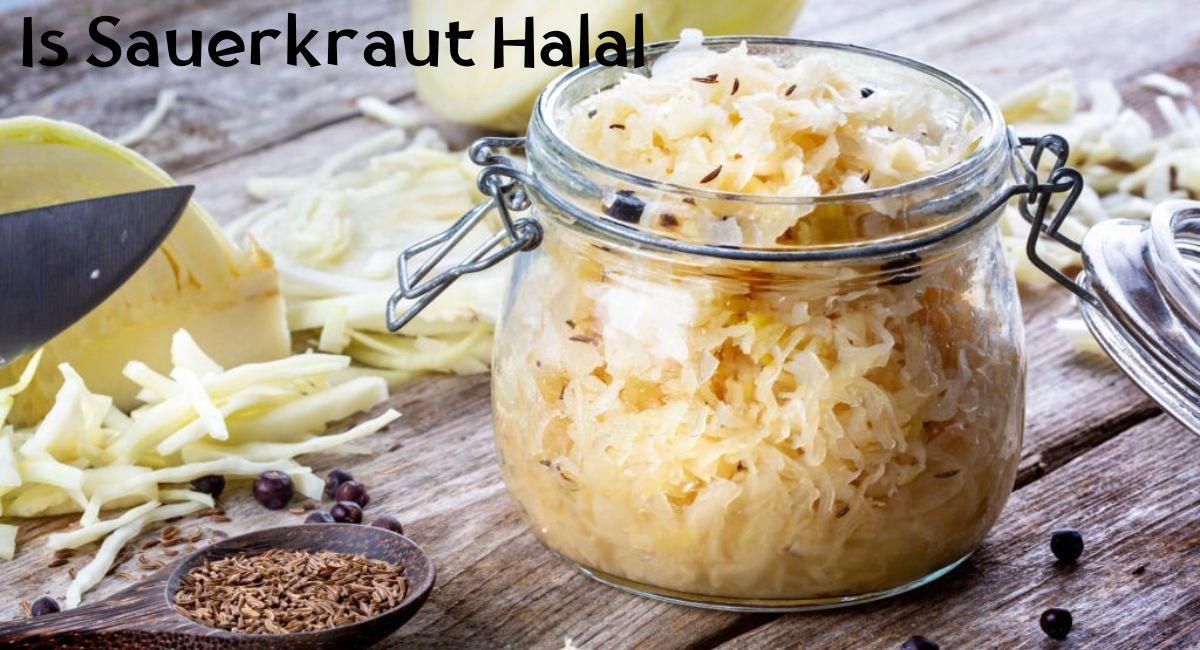Sauerkraut, a popular fermented cabbage dish, has gained recognition worldwide for its tangy flavor and potential health benefits.
For those who adhere to Islamic dietary guidelines, the question of whether sauerkraut is Halal, meaning permissible according to Islamic dietary laws, is a common one.
To determine the Halal status of sauerkraut, it is essential to consider its ingredients, preparation methods, and potential cross-contamination with non-Halal substances.
This article will explore the key factors that determine whether sauerkraut can be considered Halal, providing insights into the suitability of this fermented delicacy for Muslim consumers.
Is Sauerkraut Halal
Sauerkraut can be considered halal if it is prepared using halal ingredients and processes. The key consideration for whether sauerkraut is halal depends on the ingredients used and the methods of preparation. Here are some factors to keep in mind:
- Cabbage: Cabbage itself is a halal vegetable, so there are no concerns about its status.
- Salt: The salt used in the sauerkraut-making process should not contain any additives or ingredients that are not halal. Plain, pure salt is generally considered halal.
- Vinegar: Some sauerkraut recipes may use vinegar as part of the fermentation process. Vinegar can be halal as long as it is derived from permissible sources (e.g., grapes or apples) and the alcohol content in the vinegar has been completely transformed into acetic acid through the fermentation process. Check the source of the vinegar and the manufacturer’s process to ensure it meets halal requirements.
- Additional Ingredients: Some sauerkraut recipes may include spices, flavorings, or additives. It’s essential to verify that these ingredients are halal-certified or do not contain any haram (forbidden) substances.
- Cross-Contamination: Ensure that the sauerkraut production facilities and equipment do not have any cross-contamination with non-halal ingredients or products.
According to the fatwa (religious ruling) by Shaykh Faraz Rabbani, a leading Hanafi scholar, the incidental presence of alcohol in food items, produced through non-wine sources, does not make the food haram (forbidden), as long as certain conditions are met:
- Not being used to intoxicate: The alcohol should not be used with the intention of intoxication.
- Not being used in an amount that intoxicates: The alcohol content should be present in such a small amount that it does not have the capacity to intoxicate.
- Not being used as intoxicants are used: The alcohol should not be used in a manner similar to how intoxicating drinks are consumed.
- Not being used for vain purposes: The alcohol should not serve a useless or vain purpose.
Based on these conditions, it is permissible to consume fermented food containing a small percentage of alcohol if it meets the criteria outlined above.
If you are in doubt about the halal status of a specific sauerkraut product, it’s advisable to look for sauerkraut products that have been certified as halal by a recognized halal certification authority. These certifications can provide assurance that the product meets halal standards.
Ultimately, whether sauerkraut is halal or not depends on the specific brand and how it is prepared, so it’s important to read ingredient labels and seek halal-certified options if you have dietary restrictions based on Islamic dietary laws.
What is Sauerkraut
Sauerkraut is a fermented cabbage dish that has been enjoyed for centuries, known for its tangy flavor and crisp texture. Its history dates back over 2,000 years, with roots in Eastern Europe, particularly among the German-speaking people. The word “sauerkraut” itself is German, meaning “sour cabbage.”
The process of making sauerkraut involves thinly slicing cabbage, then fermenting it with the help of lactic acid bacteria. This fermentation process not only preserves the cabbage but also enhances its flavor and nutritional value. The earliest iterations of sauerkraut were made by simply salting cabbage and allowing it to ferment naturally.
Sauerkraut gained popularity in Europe during the medieval period and was particularly valued as a source of vitamin C during long, harsh winters when fresh produce was scarce. European immigrants brought sauerkraut recipes to the United States in the 18th and 19th centuries, where it became a staple in many American households.
During World War I and World War II, sauerkraut earned a reputation as a symbol of German culture, leading to a brief renaming of the dish as “liberty cabbage” in the United States. However, its popularity endured, and today sauerkraut is enjoyed worldwide as a flavorful condiment, side dish, or ingredient in various culinary creations. It’s also appreciated for its probiotic qualities and potential health benefits, making it a versatile and enduring part of global cuisine.
Sauerkraut Ingredients
Sauerkraut is a relatively simple dish made from just a few key ingredients, primarily cabbage and salt. Here are the basic ingredients needed to make sauerkraut:
- Cabbage: The primary ingredient is fresh cabbage. Green cabbage is the most common choice, but you can also use red cabbage or a combination of the two for added color and flavor.
- Salt: Salt is a crucial ingredient in sauerkraut as it helps to draw out moisture from the cabbage and create the brine necessary for fermentation. It also prevents the growth of harmful bacteria, allowing the beneficial lactobacilli to thrive.
That’s it for the essential ingredients. However, some variations of sauerkraut may include additional ingredients for flavor or variation. These can include:
- Caraway Seeds: Caraway seeds are a popular addition to sauerkraut and add a distinctive, slightly spicy flavor.
- Juniper Berries: Juniper berries can be used to impart a unique, piney taste to sauerkraut.
- Apples: Some recipes call for apples to add a touch of sweetness to the sauerkraut.
- Onions and Garlic: These aromatics can be included to enhance the flavor of the sauerkraut.
- Spices: Other spices like pepper, mustard seeds, or bay leaves may be added for additional flavor complexity.
Remember that the basic fermentation process relies on the cabbage and salt, but these additional ingredients can be used to customize the flavor of your sauerkraut to suit your taste preferences. The fermentation process itself, which typically takes a few weeks, transforms these simple ingredients into the tangy, probiotic-rich sauerkraut enjoyed in various dishes around the world.
How is Sauerkraut Made
Sauerkraut is made through a process of lacto-fermentation, which naturally preserves the cabbage and creates its distinctive sour flavor. Here’s a step-by-step guide on how to make sauerkraut:
Prepare the Cabbage: Remove the outer leaves of the cabbage, and set them aside. Wash the cabbage and remove any damaged or wilted outer leaves. Cut the cabbage into quarters, removing the core.
Shred the Cabbage: Using a knife, mandoline, or food processor, finely shred the cabbage into thin strips. You can vary the thickness to your preference.
Add Salt: In a large mixing bowl, combine the shredded cabbage and salt. The amount of salt needed is typically around 1-2% of the weight of the cabbage. You can start with 1 tablespoon of salt for every 2 pounds of cabbage and adjust from there.
Massage and Extract Brine: Begin massaging and squeezing the cabbage with your hands. This action helps to break down the cell walls and release the cabbage’s natural juices, creating a brine. Continue massaging for 5-10 minutes or until the cabbage becomes limp and releases enough liquid to cover itself.
Add Optional Flavorings: If desired, add any optional flavorings like caraway seeds, juniper berries, or other spices to the cabbage mixture. Mix them in evenly.
Pack into Container: Transfer the cabbage and brine into a clean, sterilized crock or glass jars. Pack it tightly, pressing down to eliminate air bubbles. Ensure the cabbage is fully submerged in the brine.
Weight It Down: Place a clean, sterilized weight (a glass jar filled with water or a purpose-made fermentation weight) on top of the cabbage to keep it submerged in the brine.
Cover and Ferment: Cover the crock or jar with a clean cloth or paper towel to keep out dust and insects. Secure it with a rubber band or string. Place the container in a cool, dark place with a temperature between 60-70°F (15-21°C) for fermentation. The process usually takes 1 to 4 weeks, depending on the temperature and your desired level of sourness. Check the sauerkraut periodically to ensure it remains submerged.
Taste and Store: When the sauerkraut reaches your preferred level of sourness, remove the weight and cloth, and taste it. If it’s to your liking, you can transfer it to a clean, airtight container and store it in the refrigerator to slow down further fermentation. It can last for several months or longer when refrigerated.
How to Use Sauerkraut
Sauerkraut is a versatile ingredient that can add a burst of tangy flavor and probiotic goodness to a wide range of dishes. Here are several ways to use sauerkraut in your cooking:
- As a Condiment: Serve sauerkraut as a condiment alongside sausages, hot dogs, or sandwiches. It complements the richness of these dishes with its tangy and crunchy texture.
- In Reuben Sandwiches: Reuben sandwiches traditionally feature sauerkraut, corned beef, Swiss cheese, and Russian dressing on rye bread. The sauerkraut adds a zesty contrast to the savory meat and cheese.
- In Tacos and Wraps: Use sauerkraut as a topping for tacos, burritos, or wraps. It provides a refreshing and tangy contrast to the fillings, whether they’re meat-based or vegetarian.
- With Grilled Meats: Pair sauerkraut with grilled sausages, pork chops, or bratwurst. The combination of the smoky, grilled flavors with the sauerkraut’s acidity is a classic and satisfying choice.
- In Salads: Add sauerkraut to salads for an extra layer of flavor and a probiotic boost. It pairs well with greens, shredded carrots, and a creamy dressing.
- In Soups and Stews: Stir sauerkraut into hearty soups and stews for a tangy kick. It works particularly well with bean-based soups or chowders.
- In Pierogi and Dumplings: Use sauerkraut as a filling for pierogi, dumplings, or savory pastries. Combine it with ingredients like potatoes, cheese, or mushrooms for a flavorful stuffing.
- In Potato Dishes: Mix sauerkraut into mashed potatoes or potato salads for a unique twist on these classic side dishes. The tangy sauerkraut pairs wonderfully with the creamy potatoes.
- As a Pizza Topping: Experiment with sauerkraut as a pizza topping. Combine it with ingredients like sausage, bacon, or onions for a tangy and savory pizza experience.
- In Stir-Fries: Add sauerkraut to stir-fry dishes for a burst of acidity and crunch. It can work well with both meat and vegetable stir-fries.
- In Breakfast Dishes: Incorporate sauerkraut into breakfast items like omelets or breakfast burritos. Its sharp flavor can add a unique dimension to your morning meal.
- In Homemade Dressings and Sauces: Blend sauerkraut into homemade salad dressings, barbecue sauces, or coleslaws to infuse them with a tangy twist.
Remember that sauerkraut is quite potent in flavor, so start with a small amount and adjust to your taste preferences. Additionally, when using sauerkraut in cooked dishes, consider adding it towards the end of the cooking process to preserve its probiotic benefits, as prolonged cooking can destroy the beneficial bacteria.
You might also like these related articles
Are Pickles Halal: Discover the Islamic perspective on pickles and whether they are considered halal or haram. This article provides insights into the ingredients and preparation methods to help you make an informed choice about enjoying this tangy snack.
Is Relish Haram: Delve into the world of relish and its halal status. This article explores the components that make up this condiment and examines whether it meets the criteria for consumption within the bounds of Islamic dietary laws.
Is Kimchi Haram: Explore the question of whether kimchi, the beloved Korean fermented dish, can be considered halal. This article sheds light on the ingredients and fermentation techniques used in kimchi preparation to help you determine its halal compatibility.
Frequently Asked Questions
1. Is there any alcohol in sauerkraut?
Generally, sauerkraut does not contain significant amounts of alcohol. The fermentation process primarily produces lactic acid, which gives sauerkraut its tangy flavor. However, in rare cases where sauerkraut is improperly fermented or stored, trace amounts of alcohol might develop, but it’s usually negligible.
2. Is sauerkraut good for you?
Yes, sauerkraut can be beneficial for your health. It is a source of probiotics, which are beneficial bacteria that can support digestive health and boost your immune system. Sauerkraut is also rich in vitamins C and K, and it provides dietary fiber. However, its health benefits are most pronounced when it’s fermented naturally (without pasteurization) to preserve the probiotics.
3. Is sauerkraut a probiotic?
Yes, sauerkraut is considered a probiotic food because it contains live beneficial bacteria, primarily lactic acid bacteria like Lactobacillus. These probiotics can aid in digestion and support a healthy gut microbiome when sauerkraut is consumed in its raw, fermented state.
4. Is sauerkraut kimchi?
No, sauerkraut and kimchi are not the same. They are both fermented cabbage dishes, but they have distinct flavors, ingredients, and origins. Sauerkraut is a German dish made from fermented green or red cabbage with salt. Kimchi, on the other hand, is a Korean dish made from fermented Napa cabbage and/or other vegetables, often seasoned with garlic, ginger, and spicy chili peppers, giving it a more complex and spicy flavor profile.
5. Is sauerkraut keto-friendly?
Yes, sauerkraut can be keto-friendly. It is relatively low in carbohydrates, making it a suitable choice for people following a ketogenic diet. However, it’s essential to check the label when buying sauerkraut, as some commercial varieties may contain added sugars. Homemade sauerkraut, or sauerkraut labeled as “sugar-free,” is a better option for those on a keto diet.
6. Is sauerkraut vegan?
Yes, sauerkraut is typically vegan. Its primary ingredients are cabbage and salt, which are plant-based. However, as with any processed food, it’s essential to check the label or verify the preparation methods to ensure there are no non-vegan additives or flavorings added to the sauerkraut. Homemade sauerkraut made with vegan-friendly ingredients is a sure vegan option.








